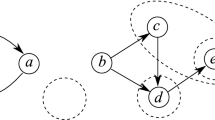Abstract
The trilattice \(\textit{SIXTEEN}_3\) is a natural generalization of the well-known bilattice \(\textit{FOUR}_2\). Cut-free, sound and complete sequent calculi for truth entailment and falsity entailment in \(\textit{SIXTEEN}_3\) are presented.
Similar content being viewed by others
References
Anderson, A. R., & Belnap, N. D. (1975). Entailment: The logic of relevance and necessity (Vol. I). Princeton, NJ: Princeton University Press.
Arieli, O., & Avron, A. (1996). Reasoning with logical bilattices, Journal of Logic, Language and Information, 5, 25–63.
Baaz, M., Fermüller, C., Salzer, G., & Zach, R. (1998). Labeled calculi and finite-valued logics. Studia Logica, 61, 7–33.
Baaz, M., Fermüller, C., & Zach, R. (1994). Elimination of cuts in first-order many-valued logics. Journal of Information Processing and Cybernetics, 29, 333–355.
Belnap, N. D. (1977). A useful four-valued logic. In J. M. Dunn, & G. Epstein (Eds.), Modern uses of multiple-valued logic (pp. 5–37). Dordrecht: Reidel.
Belnap, N. D. (1977). How a computer should think. In G. Ryle (Ed.), Contemporary aspects of philosophy (pp. 30–56). Stocksfield: Oriel Press.
Chagrov, A., & Zakharyaschev, M. (1997). Modal logic. Oxford: Clarendon Press.
Dunn, J. M. (1976). Intuitive semantics for first-degree entailment and ‘coupled trees’. Philosophical Studies, 29, 149–168.
Fitting, M. (2006). Bilattices are nice things. In T. Bolander, V. Hendricks, & S. A. Pedersen (Eds.), Self-reference (pp. 53–77). Stanford: CSLI-Publications.
Ginsberg, M. (1988). Multivalued logics: A uniform approach to reasoning in AI. Computer Intelligence, 4, 256–316.
Gottwald, S. (2001). A treatise on many-valued logic. Baldock: Research Studies Press.
Kamide, N., & Wansing, H. (2008). Alternative semantics for trilattice logics. Manuscript (30 pp.).
Kamide, N., & Wansing, H. (2009). Sequent calculi for some trilattice logics. Review of Symbolic Logic, 2, 374–395.
Miura, S. (1966). A remark on the intersection of two logics. Nagoja Mathematical Journal, 26, 167–171.
Odintsov, S. P. (2009). On axiomatizing Shramko-Wansing’s logic. Studia Logica, 93, 407–428.
Schröter, K. (1955). Methoden zur Axiomatisierung beliebiger Aussagen- und Prädikatenkalküle. Zeitschrift für mathematische Logik und Grundlagen der Mathematik, 1, 241–251.
Shramko, Y., & Wansing, H. (2005). Some useful 16-valued logics: How a computer network should think. Journal of Philosophical Logic, 34, 121–153.
Shramko, Y., & Wansing, H. (2006). Hyper-contradictions, generalized truth values and logics of truth and falsehood. Journal of Logic, Language and Information, 15, 403–424.
Troelstra, A., & Schwichtenberg, H. (2000). Basic proof theory (2nd Ed.). Cambridge: Cambridge University Press.
Wansing, H. (1998). Displaying modal logic. Dordrecht: Kluwer Academic Publishers.
Wansing, H., & Belnap, N. (2010). Generalized truth values. A reply to Dubois. To appear in Logic Journal of the Interest Group in Pure and Applied Logic. doi:10.1093/jigpal/jzp068.
Wansing, H., & Shramko, Y. (2008). A note on two ways of defining a many-valued logic. In M. Pelis (Ed.), Logica yearbook 2007 (pp. 255–266). Prague: Filosofia.
Wansing, H., & Shramko, Y. (2008). Harmonious many-valued propositional logics and the logic of computer networks. In C. Dégremont, L. Keiff, & H. Rückert (Eds.), Dialogues, logics and other strange things. Essays in honour of Shahid Rahman (pp. 491–516). London: College Publications.
Zach, R. (1993). Proof theory of finite-valued logics. Diploma thesis, Technische Universität Wien, Vienna, 1993 technical report TUW-E185.2-Z.1-93. Available at http://www.ucalgary.ca/rzach/papers/ptmvl.html.
Author information
Authors and Affiliations
Corresponding author
Rights and permissions
About this article
Cite this article
Wansing, H. The Power of Belnap: Sequent Systems for SIXTEEN 3 . J Philos Logic 39, 369–393 (2010). https://doi.org/10.1007/s10992-010-9139-1
Received:
Accepted:
Published:
Issue Date:
DOI: https://doi.org/10.1007/s10992-010-9139-1



